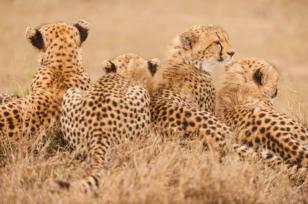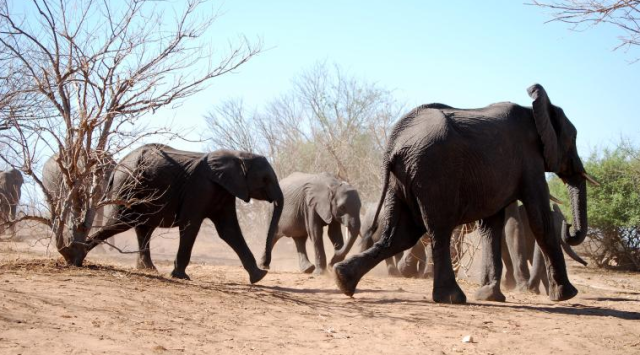China Announces the Details To Ban the Ivory Trade by the End of 2017
Earlier this month, China stated that they will finally implement plans to ban the ivory trade. State media reported last Friday that China will ban all domestic ivory trade and processing by the end of 2017, setting a deadline. Thereby, shutting the door to the world’s biggest end-market for poached ivory.
“China will gradually stop the processing and sales of ivories for commercial purposes by the end of 2017,” the official Xinhua news agency said, citing a government statement, and will affect “34 processing enterprises and 143 designated trading venues.” The State Council also mentioned that the first batch of factories and shops will need to close and hand in their licenses by March 31, 2017.

People with ivory products previously obtained through legal means can apply for certification and continue to display them in exhibitions and museums, the government announcement said. The auction of legally obtained ivory antiques, under “strict supervision”, will also be allowed after obtaining authorisation. It also mentioned that the government will also crack down on law enforcement and boost education.
China’s announcement follows Beijing’s move in March to widen a ban on imports of all ivory and ivory products acquired before 1975 after pressure to restrict the trade, which more than 20,00 elephants are killed annually for.
Conservation groups applauded the ban, with WildAid’s wildlife campaigner Alex Hofford calling it “the biggest and best conservation news of 2016”.
And Aili Kang, executive director of the Wildlife Conservation Society in Asia, praised the announced in a statement. “This is great news that will shut down the world’s largest market for elephant ivory. “I am very proud of my country for showing this leadership that will help ensure that elephants have a fighting chance to beat extinction. This is a game changer for Africa’s elephants.”
WWF Hong Kong’s Senior Wildlife Crime Officer Cheryl Lo said the bold timeline “shows determination to help save Africa’s elephants from extinction”.
But he also calls on Hong Kong to bring forward a plan to end its ivory trade by 2021. “With China’s market closed, Hong Kong can become a preferred market for traffickers to launder illegal ivory under cover of the legal ivory trade,” he explains.
China to Ban Domestic Ivory Trade by End of 2017
China to ban ivory trade by the end of 2017
Cheetahs No Longer Safe, Latest Census Suggests Possible Extinction

The world’s fastest land mammal is racing toward extinction, with the latest cheetah census suggesting that the big cats, which are already few in number, may decline by an additional 53% over the next 15 years.
“That’s really perilous,” says Luke Hunter, president and CCO for Panthera, the global wild cat conservation organization. “That’s a very active decline, and you have to really step in and act to address that.”
According to a new study, which appeared this week in the Proceedings of the National Academy of Sciences, there are just 7,100 cheetahs left in the wild. That’s down from the estimated 14,000 cheetahs in 1975, when researchers made the last comprehensive count of the animals across the African continent, Hunter says.
In addition, the cheetah has been driven out of 91 percent of its historic range—the big cats once roamed nearly all of Africa and much of Asia, when the global population numbered over 100,000. Since 1900, the feline has gone extinct in more than 20 countries and their population is now confined predominantly to six African countries: Angola, Namibia, Zimbabwe, Botswana, South Africa, and Mozambique. The species is already almost extinct in Asia, with fewer than 50 individuals remaining in one isolated pocket of Iran.
“Given the secretive nature of this elusive cat, it has been difficult to gather hard information on the species, leading to its plight being overlooked,’ said Sarah Durant, the report’s lead author and researcher at the Zoological Society of London and the Wildlife Conservation Society says in the press release.
“Our findings show that the large space requirements for the cheetah, coupled with the complex range of threats faced by the species in the wild, mean that it is likely to be much more vulnerable to extinction than was previously thought. Governments are often required to monitor their wildlife inside protected areas, but not outside them,” Durant continues. “And monitoring is harder to do outside, because cheetah are shy and their densities are lower. We have no data.”

Based on these results, the study authors and the organizations supporting the study – Zoological Society of London, Panthera, and Wildlife Conservation Society – are calling for the cheetah’s status to be upgraded from “vulnerable” to “endangered” on the IUCN Red List.
“These large carnivores, when they are declining at that sort of rate, then extinction becomes a real possibility,” Hunter comments.
Perhaps unsurprising, humans are the man reason that cheetahs are in peril. Like other carnivores, cheetahs face habitat loss driven by conversion of wilderness areas into managed land dedicated to agriculture or livestock. In addition, illegal poaching and the trafficking of cheetahs as exotic pets as well as humans overhunting their prey for bushmeat have all driven the cheetahs out of 91% of their historic range across Africa and Asia.
“Cheetahs are facing a double whammy: They are getting killed directly, and then also their prey species are getting killed in these savannah areas, so the cheetahs having nothing to subsist on,” Hunter argues.
Furthermore, according to the study, 77% of cheetahs live outside of non-protected areas, which are more vulnerable to human threats. This is due to the animals need to have room to roam; individual cheetahs can have a range as large as Manhattan. Because many live in non-protected areas, they often come into conflict with humans and their livestock, which will lead to retaliation and hunting of cheetahs.
“We can’t have any more cheetahs in [current] protected areas … the density is already the maximum it can be,” Durant says. “The key to the survival of the cheetah is its survival outside of protected areas.”

Hunter adds that it is likely too late to grow and protect the species in areas like West or Central Africa, where these big cats have long been on the decline. But, there is enormous potential for the population to rebound quickly in other areas. With a new conservation status, the cheetahs would have a platform for conservation groups to try and reverse the trends affecting cheetahs. For instance, such a change can create openings for funding streams that are available only to endangered species, and they might allow for conversations with African governments about cheetah conservation programs.
“What we are really hoping,” Durant says, “is this will catalyze action to start thinking outside the box for cheetah and landscape conservation, to start looking beyond the protected-area system and looking at how we can get communities engaged in and supportive of conservation, and make sure we have the policy and financial policy framework in place so that they will benefit from conservation.”
Cheetahs Are Dangerously Close to Extinction
Cheetah Populations Plummet as They Race Toward Extinction
Cheetahs are dropping fast and are in danger of extinction
Research Reveals that Climate Change Might Be Driving Birds to Migrate Early
Migrating birds are responding to the effects of climate change by arriving at their breeding grounds earlier as global temperatures rise, research has found.
The University of Edinburgh study, which looked at hundreds of migratory species across five continents, found that birds are reaching their summer breeding grounds on average about one day earlier per degree of increasing global temperature. The researchers also examined records of migrating bird species dating back almost 300 years, drawing upon records from amateur enthusiasts and scientists, including notes from the 19th century American naturalist Henry David Thoreau.
The main reason that birds take flight is changing seasonal temperatures and food ability. So the time they reach their summer breeding grounds is significant. If the birds arrive at the wrong time, even by a few days, this may cause them to miss out on vital resources such as food and nesting places. This in turn will affect the timing of offspring hatching and their chances of survival.
It is the hope of the researchers that their study, published in the Journal of Animal Ecology and supported by the Natural Environment Research Council, would help scientists to better predict how different species will respond to environmental changes. Long-distance migrants, which are shown to be less responsive to rising temperatures, may suffer most as other birds gain advantage by arriving at breeding grounds ahead of them.
Climate change driving birds to migrate early, research reveals


 “It’s been remarkable to see the way they will identify areas they see as safe and move rapidly through areas they don’t see as safe,” says Wittemyer.
“It’s been remarkable to see the way they will identify areas they see as safe and move rapidly through areas they don’t see as safe,” says Wittemyer.




 In 2013, the documentary “Blackfish” casted SeaWorld in harsh light for raising captured young orcas in dark, cramped conditions. It also recounted the 2010 death of veteran SeaWorld trainer Dawn Brancheau by a killer whale named Tilikum. Since then, stock and attendance fell at the world’s largest marine park: SeaWorld.
In 2013, the documentary “Blackfish” casted SeaWorld in harsh light for raising captured young orcas in dark, cramped conditions. It also recounted the 2010 death of veteran SeaWorld trainer Dawn Brancheau by a killer whale named Tilikum. Since then, stock and attendance fell at the world’s largest marine park: SeaWorld.


